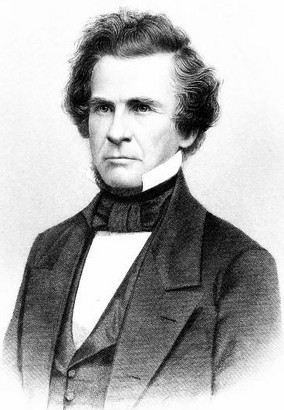Ormsby M. Mitchel facts for kids
Quick facts for kids
Ormsby MacKnight Mitchel
|
|
|---|---|
 |
|
| Nickname(s) | Old Stars |
| Born | August 28, 1810 Union County, Kentucky |
| Died | October 31, 1862 (aged 52) Beaufort, South Carolina |
| Place of burial | |
| Allegiance | United States of America Union |
| Service/ |
United States Army Union Army |
| Years of service | 1829–1832, 1861–1862 |
| Rank | |
| Commands held | Department of the Ohio X Corps Department of the South |
| Battles/wars | American Civil War
|
| Other work | Astronomer |
| Signature | |
Ormsby MacKnight Mitchel (born August 28, 1810 – died October 31, 1862) was an American astronomer and a major general during the American Civil War. He was a very talented person who excelled in many different fields.
He is known for starting the first astronomy magazine in the United States. He is also famous for ordering a secret mission during the Civil War, which became known as the Great Locomotive Chase.
Contents
Early Life and His Love for Stars
Mitchel was born in Union County, Kentucky, but he grew up in Lebanon, Ohio. He went to the West Point military school in 1825. There, he was classmates with famous generals like Robert E. Lee. He graduated in 1829 and stayed at West Point for three years as a math teacher.
After leaving the army, Mitchel studied law and became a lawyer in Cincinnati. He also worked as an engineer for the Little Miami Railroad. In 1836, he became a professor of math and astronomy at Cincinnati College. This is where his passion for astronomy truly shined.
Building an Observatory
Mitchel dreamed of having a powerful telescope. To make this happen, he gave many lectures about astronomy to get people interested. At first, only a few people came, but soon, thousands were listening! He used this excitement to create the Cincinnati Astronomical Society.
With money from the society, he traveled to Europe to find a telescope. When he returned, he worked hard to build an observatory in Cincinnati. A man named Nicholas Longworth donated land on Mt. Adams for the observatory. Former President John Quincy Adams even spoke at the groundbreaking ceremony.
Building the observatory was a huge challenge. Mitchel had to collect money and materials himself. He even helped with the physical labor, like burning lime and shoveling sand. He worked tirelessly while also teaching his classes five hours a day. His hard work paid off, and in March 1845, the telescope was finally in place. It was the second-largest refracting telescope in the world at that time.
Mitchel continued his astronomy work, even without a salary from the observatory. He supported himself by working as a civil engineer and giving lectures. In 1859, he became an astronomer at the Dudley Observatory in Albany, New York. He also helped set up observatories for the United States Navy and Harvard University. In 1846, he published the first monthly magazine in the U.S. specifically about astronomy, called Sidereal Messenger.
Serving in the Civil War
When the American Civil War began, Ormsby Mitchel joined the Union Army. He was made a brigadier general. He first helped organize defenses around Cincinnati in northern Kentucky.
The Great Locomotive Chase
From September to November 1861, Mitchel was in charge of the Department of the Ohio. During this time, he planned a secret mission with a spy named James J. Andrews. The plan was to steal a train in Georgia and damage a railroad important to the Confederate States Army. This would help Mitchel's planned attack on Chattanooga, Tennessee.
The mission, known as the Great Locomotive Chase, did not go as planned. Andrews and many of his men were captured. Some were executed by Confederate forces. However, their brave story became very famous. It inspired the 1926 silent film The General and the 1956 Walt Disney film The Great Locomotive Chase.
Military Successes and Final Days
Mitchel led a division in the Army of the Ohio from December 1861 to July 1862. He was put in charge of defending Nashville, Tennessee. He became well-known when he captured the city of Huntsville, Alabama in April 1862 without a fight. He surprised the Confederates by leading his troops there quickly. For this success, he was promoted to major general.
In September 1862, he took command of the X Corps and the Department of the South in Hilton Head, South Carolina. Sadly, he died shortly after, in Beaufort, from yellow fever. He is buried in Green-Wood Cemetery in Brooklyn, New York.
Legacy and Honors
Ormsby MacKnight Mitchel is remembered in several ways:
- Mitchellville, S.C., an African American community on Hilton Head Island, was named after him.
- A bright area near the south pole of Mars is named 'The Mountains of Mitchel' because he observed it in 1846.
- An impact crater on Mars is also named in his honor.
- The city of Mitchell, Indiana was named for him after he surveyed the area.
- Fort Mitchell, Kentucky was also named after him.
- A descendant, Lt. Ormsby M. Mitchel Jr., received the Navy Cross in 1943 for his bravery during World War II.
See also
- List of American Civil War generals (Union)


